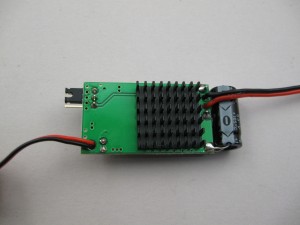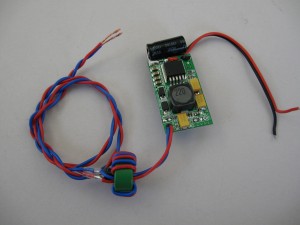Heatsink Test
 Still running 11.1V input and a 2A load, the temperatures are 106 deg-C and 84 deg-C (regulator/inductor). The input capacitor is at 49 deg-C. Still running 11.1V input and a 2A load, the temperatures are 106 deg-C and 84 deg-C (regulator/inductor). The input capacitor is at 49 deg-C.
With the small stick-on heat-sink on the back of the circuit board, the temperatures dropped slightly to 82 deg-C and 71 deg-C. The heatsink is running at about 88 deg-C.
Load to 2.5 Amps
With the heatsink, running the load at 2.5 Amps results in a 1.6A input current at 11.1V. This exceeds the continuous rating of the reverse protection diode. The heatsink temperature rises to 103 deg-C with the other temperatures at 118 deg-C and 85 deg-C.
Other Improvements
The output capacitors are 100uF 6V aluminium electrolytic. Considering that the output can be set to 6V, using a 6V rated output capacitor is cutting it a bit fine when failure is probably going to hurt.
I will replace these 3 capacitors with tantalums rated 10V or 16V and do some more testing.
The voltage select jumper can also be replaced with a soldered link. Mostly just to tidy it up. Removing the jumper defaults the output to 5V.
Update:
 I have replaced the output capacitors, permanently selected 6V output and improved the output wiring and filter. The heatsink is still on the back. I have replaced the output capacitors, permanently selected 6V output and improved the output wiring and filter. The heatsink is still on the back.
The wiring is 0.5mm cores from security cable. The filter includes a 220uF 10V capacitor. Output noise is now about 45mV P-P with a 2 Amp load.
With 6V output selected, you only just get 6V and under load it drops slightly. I’m still getting 5.8V at 2 Amps.
I also increased the output load briefly, just to see how it would cope. At 3.5 Amps it still delivers 5.5V. That’s as far as I went; But not bad.
|